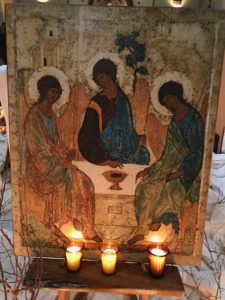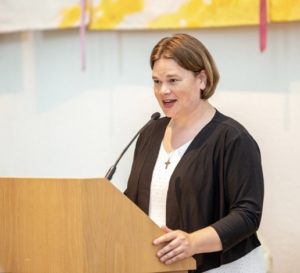“We believe in one God, the Father Almighty…we believe in one Lord, Jesus Christ…we believe in the Holy Spirit, the Lord, the Giver of life…”
I grew up, and perhaps you did as well, going to Sunday Mass and reciting these lines of the Nicene Creed in the liturgy. However, it wasn’t until I was a young adult sitting in a classroom at the Boston College School of Theology and Ministry that a light bulb went off for me: the “shape” of our Catholic faith proclamation is Trinitarian. In collectively naming our belief, there are three movements, each one reflecting the three Persons of the Trinity. The Trinity provides the frame for our articulation of faith. This truth confounds and/or delights scholars, mystics, theologians: at the heart of God’s very Self is relationality.
Catherine Mowry LaCugna rightly noted that “Only a fool would be so bold as to presume to speak authoritatively about God’s ineffable mystery” (God For Us: The Trinity and Christian Life [HarperOne, 1992], 324). I hope not to be a fool in these reflections here, and humbly recognize the musings presented here are simply that – musings that invite conversation in seeking truth, not definitive or polished conclusions.
Since St. Augustine penned De Trinitate in the Fifth Century, preachers have reached for language or images to shed light on the mystery of the Trinity. Sunday School children are told the story of St Patrick’s shamrock. Many of us have seen or prayed with Rublev’s famous icon which invites the viewer into communion with the three Persons. St Augustine wrote of the faculties of the mind – intellect, memory, and will. Franciscan preacher Richard Rohr suggests the image of Trinity as a water wheel, dynamically and eternally self-filling and self-emptying.

Despite these and many other images, despite centuries of scholarship, Karl Rahner, SJ noted that “most Christians are, in their practical lives, almost mere ‘monotheists,’” and not truly Trinitarian at all.
My late Sinsinawa Dominican Sister Anne Marie Mongoven, OP wrote, “recognizing God as a loving Trinity enables human beings to sing and dance and live with deep delight” (Trinity: A Story of Deep Delight [Columba Press, 2017].
So the question becomes: how do we become truly Trinitarian, recognizing God “as a loving Trinity” and be drawn into this deep delight?
Preaching and teaching on the Trinity can seem heady or esoteric – though we proclaim it each week, celebrate it one Sunday every June – does the image of God as Trinity really function within us? Moreover, might the insights of New Cosmology offer images or language that add something to the contemplation of God as Trinity, and our Christian lives that flow from that contemplation?
My hunch: what if the more we learn about interconnectedness and interdependence in the natural world – from subatomic particles to the movement of the planets and everything in between – the clearer the lens we have to imagine/ponder/grapple with the mystery of God as Relationship? What if dialogue with science can break open new ways for our reverent, awe-filled wandering around in mystery of God as Trinity?
“Trinity is not merely the condition for evolution but the dynamic, flowing movement of evolution – Love poured out into Word continuously breathed anew in Spirit. Evolution is Trinity enfolding space-time, not only in this visible universe but in all universes where there is capacity for love,” writes Ilia Delio (The Unbearable Wholeness of Being: God, Evolution, and the Power of Love [Orbis, 2013], 71).
If God is Relationship, and we are made in God’s image and likeness, of course it follows our own nature deeply reflects this relationality. Brazilian ecofeminist Ivone Gebhara posits that this foundational truth of relationship even more fundamental than our capacity for consciousness. “Relatedness is more vital than any consciousness and lies within it. A human being is first of all a being in relationship, then consciousness, then creativity,” she writes.
Can we take another step and say that all God’s creation (that is to say: you, me, orca whales, amoebas, sugar maple trees, the Mississippi River, etc.) reflects this relationality and deep interconnectedness?
This interconnectedness of all things is a central theme in Pope Francis’ encyclical Laudato Si. “In this universe, shaped by open and intercommunicating systems, we can discern countless forms of relationship and participation.” We are connected to one another and connected to the natural world, intimately. In the words of the Catechism, quoted by Pope Francis in Laudato Si, paragraph 86: “God wills the interdependence of creatures. Creatures exist only in dependence on each other, to complete each other, in the service of one another.”
We are not apart from nature, we are a part of nature. Again, Pope Francis in Laudato Si: “Nature cannot be regarded as something separate from ourselves or a mere setting in which we live. We are a part of nature, included in it and thus in constant interaction with it.”
How does looking at the mystery of Trinitarian divine love through this lens deepen your capacity for “deep delight,” and call you to greater conversion?
What might Delio’s lens of seeing God as Trinity as “evolution enfolding in space-time” mean for individuals, communities, the Church? Please share in the comments what is stirring in you, or what you are reading that might enrich my initial musings.

A note to commentators from Laurie Brink, OP: I am a Catholic Christian scholar for whom the Gospel directs not only my teaching, but my actions and hopefully my speech. I look forward to your insights, but I ask that in the spirit of Christian charity and courteous discourse you write with love and civility. Uncharitable or discourteous speech has no place in thoughtful dialogue.
“Let no evil talk come out of your mouths, but only what is useful for building up, as there is need, so that your words may give grace to those who hear” (Eph 4:29).
Yes, Rhonda. I’ve been rereading Laudato Is recently, and I too have been struck by the theme of interconnectedness. Perhaps the single worse “sin,” which we are all constantly resisting, is to somehow think as if each of us is the center of the universe and not connected to everyone and everything else.
Thank you, Win, for your comment. Indeed, I’ve been grateful to be teaching Laudato Si again this semester and journeying through text with twenty sophomores at the University. Your comment makes me think about the concept of “incurvatus in se” – the heart turned in on itself. It seems that the language of the New Cosmology and Pope Francis’ vision in Laudato Si give us new lenses through which to think about the sin of disconnection and blindness to the fundamental truth of deep interconnectedness. I also find this to be a powerful point of departure for dialogue with our… Read more »
I do it with photography. Every photo i take is a theological reflection on cosmological, connected relationality with the Divine Dance, cf. Richard Rohr; the nous, cf. Teilfard, etc, etc. Cannot post photos on the blog, see your FB page.
Donna, thank you so much for sharing the beautiful and evocative images! You certainly engage in “preaching through the arts” with your photography.
Rhonda- From your “my hunch” to the end of your reflection, let me offer an enthusiastic AMEN and deep gratitude. Evolutionary Consciousness is, for me, transforming revelation! Neither religion nor science nor the profound relationship between them can be appreciated without a deep respect for the limitations of human language and our dependence on metaphor and other figures of speech 😉.
Jean, thank you for your comment. Yes, your comment points to something Laurie and I have come across in our research and trying to figure out the limits to language, and the importance of not “muddying the waters” of thinking through interchanging glibly the language of theology and the language of science. Of course, God is beyond any human articulation, which calls us back to a deep humility to the limits of what we can know.
All is cradled in the heart of the Divine Soul. In what some call trinity, we find distinction yet no separateness. All is One.
Thank you for your comment, Caroline. Indeed, Trinity is such a beautiful paradox threeness yet oneness, simultaneously. I also appreciate how our Jewish and Muslim brothers and sisters share this deep understanding of God’s oneness, and feel like it opens the door for good interfaith dialogue among Abrahamic traditions.
Ah, sweet Mystery of Life! I’m relishing your vibrant waves of energy , Rhonda. and thank you for connecting a few more dots in the amazing
Story of the Universe……….judy lund
Thank you reading and taking the time to offer these words of delight, Judy. Amazing, sweet, and mysterious indeed – thanks be to God.